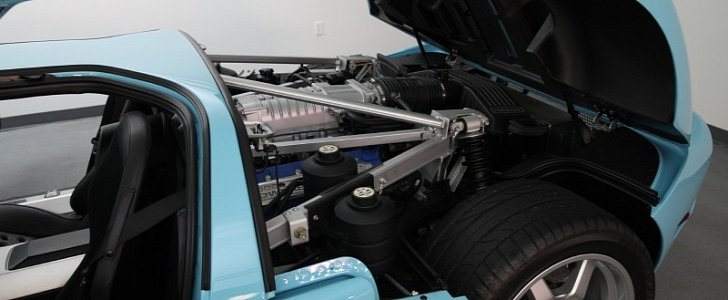We all know the story, more so because of the Ford v. Ferrari blockbuster movie. The GT40 took some development to become competitive, a historically significant car for both the road but especially the track.
Ford cherishes the historical significance of the GT40 so much that it had brought it back not once but twice with a supercharged V8 and a twin-turbo V6, respectively. However, the first incarnation of the GT may have gotten an aluminum-alloy V10 according to chief designer Camilo Pardo.
Speaking to Hot Rod magazine, the man behind the beautiful lines of the mid-engine supercar said that chief engineer and SVT boss John Coletti as well as a gentleman by the name of Carroll Shelby wanted a big V10 engine. “The decision was to take the best engine that Ford had, reproduce it in aluminum, and then put a supercharger on it,” remembers Pardo.
At the time, the Triton 6.8-liter V10 from the Modular family would have been the culprit. As fate would have it, the bore and stroke are shared with the 5.4-liter V8 that actually got to power the GT Gen 1.
If memory serves me well, many people were expecting a ten-cylinder motor instead of a four-valve-per-cylinder V8 with an Eaton 2300 screw-type blower, dual fuel injectors, and dry-sump lubrication. With a V10, the Ford Motor Company and SVT could have taken the battle to Dodge and SRT who had the front-engined Viper to offer at that time. The Viper, however, is gone while the GT soldiers on with a peculiarly named six-cylinder plant.
EcoBoost, ladies and gentlemen, implies eco-friendly stuff and forced induction. However, the GT Gen 2 is rated at 14 miles to the gallon on the combined driving cycle. In other words, this EcoBoost isn’t exactly sipping on fuel considering the gas-guzzler tax of approximately $3,000.
To understand how performance-oriented the 3.5-liter V6, you only need to look at the ratings for the F-150 Raptor and Lincoln Navigator. Sharing the high-output version of the EcoBoost engine, those two average 16 and 18 miles to the gallon, 4WD and long-wheelbase option included.
Speaking to Hot Rod magazine, the man behind the beautiful lines of the mid-engine supercar said that chief engineer and SVT boss John Coletti as well as a gentleman by the name of Carroll Shelby wanted a big V10 engine. “The decision was to take the best engine that Ford had, reproduce it in aluminum, and then put a supercharger on it,” remembers Pardo.
At the time, the Triton 6.8-liter V10 from the Modular family would have been the culprit. As fate would have it, the bore and stroke are shared with the 5.4-liter V8 that actually got to power the GT Gen 1.
If memory serves me well, many people were expecting a ten-cylinder motor instead of a four-valve-per-cylinder V8 with an Eaton 2300 screw-type blower, dual fuel injectors, and dry-sump lubrication. With a V10, the Ford Motor Company and SVT could have taken the battle to Dodge and SRT who had the front-engined Viper to offer at that time. The Viper, however, is gone while the GT soldiers on with a peculiarly named six-cylinder plant.
EcoBoost, ladies and gentlemen, implies eco-friendly stuff and forced induction. However, the GT Gen 2 is rated at 14 miles to the gallon on the combined driving cycle. In other words, this EcoBoost isn’t exactly sipping on fuel considering the gas-guzzler tax of approximately $3,000.
To understand how performance-oriented the 3.5-liter V6, you only need to look at the ratings for the F-150 Raptor and Lincoln Navigator. Sharing the high-output version of the EcoBoost engine, those two average 16 and 18 miles to the gallon, 4WD and long-wheelbase option included.























